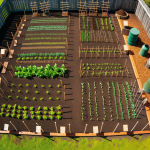Key Takeaway: Here are the 5 Expert-Tested Seating Area Ideas. Creating the perfect garden seating area combines experience and expertise. By implementing these five diverse seating ideas – rustic log benches, cozy nooks, versatile deck seating, hammock havens, and upcycled pallet furniture – you can transform your outdoor space into a comfortable and inviting retreat that reflects both your personal style and proven design principles.
Introduction
A garden is more than just a collection of plants; it’s an extension of your living space, a sanctuary where you can connect with nature and find peace amidst the hustle and bustle of daily life. One of the key elements that can elevate your garden from a mere visual delight to a functional outdoor living area is thoughtfully designed seating. As someone who has spent years cultivating my own garden oasis, I’ve learned through trial and error the importance of comfortable, well-placed seating areas.
Whether you have a sprawling backyard or a cozy urban patio, these ideas will inspire you to create inviting spaces where you can relax, entertain, and fully enjoy your outdoor haven. Let’s dive in and discover how you can transform your garden into a comfortable retreat that beckons you to linger and unwind.
1. Rustic Log Benches: Embracing Nature’s Seating
There’s something undeniably charming about rustic log benches. These natural seating options bring a touch of woodland whimsy to any garden, creating a seamless blend between your cultivated space and the wild beauty of nature.
My Experience with Log Benches
When I first introduced log benches to my garden, I was amazed at how they instantly transformed the atmosphere. Placed strategically along a winding path, these benches invited exploration and provided perfect spots for quiet contemplation. I found that guests were naturally drawn to them, often running their hands along the smooth, weathered surfaces as they sat.
One particularly memorable experience was watching my young niece discover a family of ladybugs nestled in the bark of one bench. It became a magical moment of connection with nature that a more polished seating option might not have facilitated.
Expert Tips for Creating Log Benches
While my personal experience highlights the charm of log benches, it’s crucial to consider expert advice for their creation and maintenance. According to Sarah Eberle, a renowned landscape architect and gold medal winner at the Chelsea Flower Show, the key to successful log benches lies in the selection and preparation of the wood.
“Choose hardwoods like oak, cedar, or locust for their durability and natural resistance to decay,” Eberle advises. “Ensure the logs are properly dried to prevent cracking and splitting, and consider applying a natural sealant to extend their lifespan.”
For those concerned about sustainability, the Royal Horticultural Society recommends using locally sourced wood or repurposing fallen trees from your own property when possible.
Creating Your Own Log Bench
To create your own log bench:
- Select a log about 18 inches in diameter and 4-6 feet long.
- Strip the bark to deter insects and prevent decay.
- Sand the seating surface for comfort.
- Apply a natural, eco-friendly sealant to protect against the elements.
- Place the bench on level ground, using small pebbles or sand to ensure stability.
Remember, the beauty of log benches lies in their imperfections. Embrace the knots, grooves, and natural contours of the wood to create truly unique seating that tells a story and invites connection with nature.

2. Cozy Garden Nook: Your Outdoor Retreat
Every garden deserves a secret spot, a cozy nook where you can escape the world and immerse yourself in the beauty of your outdoor space. Creating such a haven combines the art of gardening with the principles of outdoor room design, resulting in a uniquely personal retreat.
Personal Reflections on Garden Nooks
My own garden nook evolved organically over time. What started as a forgotten corner behind a large rhododendron gradually transformed into my favorite spot in the entire garden. I added a small, weathered bench, surrounded it with fragrant herbs and climbing roses, and crowned it with a simple pergola draped in wisteria.
This secluded spot became my go-to place for morning coffee, afternoon reading, and evening stargazing. The secret to its allure, I discovered, was the sense of enclosure combined with carefully curated views of the wider garden. It felt both connected to and separate from the rest of the space, offering a unique perspective that never failed to refresh my spirit.
Expert Insights on Creating Garden Nooks
While personal preference plays a significant role in designing a garden nook, expert advice can elevate your space from good to exceptional. Landscape designer Jinny Blom, known for her thoughtful and naturalistic approach, emphasizes the importance of considering all senses when creating intimate garden spaces.
“A successful garden nook engages more than just the eyes,” Blom explains. “Consider the texture of materials underfoot, the fragrance of nearby plants, the sound of rustling leaves or water features, and the play of light and shadow throughout the day.”
The Royal Horticultural Society also highlights the importance of scale in creating cozy nooks. They recommend using the “rule of thirds” when designing your space: divide your nook into thirds both horizontally and vertically, and place key elements along these lines for a balanced and inviting composition.
Steps to Create Your Own Garden Nook
- Choose a location that offers some natural enclosure, such as near a wall or large shrubs.
- Define the space with landscaping elements like trellises, small trees, or tall perennials.
- Select comfortable, weather-resistant seating that fits the scale of your nook.
- Add layers of plants for visual interest and to enhance the sense of enclosure.
- Incorporate sensory elements like fragrant herbs or a small water feature.
- Consider lighting for evening ambiance, such as solar-powered lanterns or fairy lights.
- Personalize the space with meaningful decorative elements or artwork.
Remember, the goal is to create a space that feels like a natural extension of your garden while offering a unique and intimate experience. Let your personal style shine through, but don’t be afraid to seek inspiration from expert sources to refine your design.
3. Versatile Deck Seating: Expanding Your Outdoor Living Space
A well-designed deck can significantly expand your outdoor living space, providing a versatile area for relaxation, entertainment, and enjoying your garden from a different perspective. The key to successful deck seating lies in its flexibility and integration with your home and garden.

My Journey with Deck Seating
When I decided to add a deck to my home, I initially underestimated its potential impact on my garden experience. What began as a simple platform quickly evolved into a multi-functional outdoor room that became the heart of my garden entertaining.
I experimented with various seating arrangements, from built-in benches along the perimeter to movable furniture that could be reconfigured based on the occasion. One of my most successful additions was a corner banquette with storage underneath, which provided ample seating for larger gatherings while offering a practical solution for storing outdoor cushions and garden tools.
The deck also offered a new vantage point from which to appreciate my garden. Elevated slightly above ground level, it provided a different perspective on the layout and allowed me to identify areas that needed attention or redesign.
Expert Advice on Deck Design and Seating
While personal experience taught me the value of versatility in deck seating, expert insight is crucial for ensuring your deck is both beautiful and functional. According to Scott Cohen, a renowned garden designer and author, the key to successful deck seating lies in understanding traffic flow and creating distinct zones.
“Think of your deck as an outdoor room with different areas for different activities,” Cohen advises. “Create conversation areas, dining spaces, and spots for solitary relaxation. Use the orientation of seating to frame garden views and create a seamless transition between the deck and the surrounding landscape.”
The American Society of Landscape Architects emphasizes the importance of considering materials when designing deck seating. They recommend choosing materials that complement both your home’s architecture and your garden’s style, while also considering factors like durability, maintenance, and environmental impact.
Creating Versatile Deck Seating
To create versatile and inviting deck seating:
- Plan your deck layout with distinct zones for different activities.
- Incorporate a mix of built-in and movable seating options for flexibility.
- Choose weather-resistant materials that complement your home and garden aesthetic.
- Consider adding shade elements like pergolas or retractable awnings for comfort.
- Integrate storage solutions into seating designs where possible.
- Use planters and container gardens to soften the transition between deck and garden.
- Install appropriate lighting for evening use and ambiance.
Remember, the goal is to create a space that feels like a natural extension of both your home and garden. By combining personal insights with expert recommendations, you can design a deck seating area that enhances your outdoor living experience and provides a perfect vantage point from which to enjoy your garden.
4. Hammock Haven: Suspended Bliss in Your Garden
There’s something inherently relaxing about gently swaying in a hammock, suspended between two points in your garden. A well-placed hammock can transform an ordinary space into a haven of tranquility, inviting you to slow down and appreciate the beauty of your surroundings from a unique perspective.
Personal Experiences with Garden Hammocks
My love affair with garden hammocks began on a trip to Central America, where I was struck by how seamlessly they were integrated into outdoor living spaces. Inspired, I decided to bring that sense of laid-back luxury to my own garden.
Initially, I struggled to find the perfect spot, balancing the need for sturdy support with the desire for an appealing view. After some trial and error, I found success by creating a dedicated “hammock grove” using mature trees supplemented by sturdy posts disguised as rustic pillars.
The impact on my garden experience was profound. The hammock quickly became my favorite spot for afternoon naps, stargazing, and even outdoor reading sessions. I discovered that the gentle motion and unique vantage point offered a new way to appreciate my garden, noticing details in the canopy and sky that I had previously overlooked.
Expert Insights on Hammock Integration
While personal experience can guide the placement and enjoyment of a garden hammock, expert advice is crucial for ensuring safety and longevity. Christopher Richter, a landscape architect known for his innovative outdoor living designs, emphasizes the importance of proper support and integration with the overall garden design.
“When incorporating a hammock, think beyond just the hanging points,” Richter advises. “Consider the journey to the hammock, what you’ll see while lying in it, and how it fits into the overall flow of your garden. A well-placed hammock should feel like a natural part of the landscape, not an afterthought.”
The National Garden Bureau also highlights the importance of choosing the right type of hammock for your space and climate. They recommend considering factors like material durability, weather resistance, and ease of storage when selecting a hammock for your garden.
Creating Your Own Hammock Haven
To create a blissful hammock area in your garden:
- Choose a location with adequate support (trees, posts, or a dedicated hammock stand) and an appealing view.
- Ensure the support points are sturdy and properly anchored.
- Select a hammock style and material suitable for outdoor use in your climate.
- Create a clear, inviting path to your hammock area.
- Enhance the space around the hammock with complementary plantings, perhaps focusing on fragrant plants or those with interesting textures.
- Consider adding outdoor lighting for evening use.
- Include a small side table or storage solution for books, drinks, or other relaxation essentials.
Remember, the key to a successful hammock haven is creating a space that invites relaxation and connects you with your garden environment. By combining the laid-back luxury of a hammock with thoughtful landscape design, you can create a truly special retreat within your garden.
5. Upcycled Pallet Furniture: Sustainable Style for Your Garden
In an era where sustainability is increasingly important, upcycled pallet furniture offers a creative, eco-friendly, and budget-conscious solution for garden seating. This DIY approach not only reduces waste but also allows for customization to perfectly suit your garden’s style and needs.
My Experience with Pallet Furniture
My journey into the world of pallet furniture began as a cost-saving measure but quickly evolved into a passionate hobby. What started with a simple pallet bench soon expanded to include a coffee table, planter boxes, and even a novel vertical herb garden with integrated seating.
One of my favorite projects was creating a modular seating arrangement that could be easily reconfigured for different occasions. The flexibility this offered was a game-changer for garden parties, allowing me to quickly adapt the space for intimate gatherings or larger celebrations.
I found that the raw, rustic aesthetic of pallet furniture added a charming, organic feel to my garden. It seemed to bridge the gap between the cultivated areas and the wilder, more natural parts of the landscape. Plus, the satisfaction of creating functional, attractive furniture with my own hands was immensely rewarding.
Expert Advice on Upcycled Pallet Furniture
While DIY pallet projects can be incredibly satisfying, it’s important to approach them with knowledge and care. Ana White, a renowned DIY furniture designer, emphasizes the importance of proper pallet selection and preparation.
“Not all pallets are created equal,” White cautions. “Look for pallets marked with ‘HT’ (heat treated) rather than ‘MB’ (methyl bromide), and avoid those with obvious stains or strong odors. Always clean and sand your pallets thoroughly before use to ensure safety and comfort.”
The Royal Horticultural Society also provides valuable insights on creating garden furniture, highlighting the importance of weatherproofing and maintenance. They recommend using appropriate outdoor finishes and regularly inspecting and treating your pallet furniture to ensure longevity.
Creating Your Own Pallet Furniture
To create safe and attractive pallet furniture for your garden:
- Source pallets from reputable locations, ensuring they’re clean and chemical-free.
- Disassemble pallets carefully, removing all nails and staples.
- Sand all surfaces thoroughly to prevent splinters.
- Design your furniture with both aesthetics and functionality in mind.
- Use weather-resistant screws and brackets for assembly.
- Apply an outdoor sealant or paint to protect against the elements.
- Add cushions or pillows made with outdoor fabric for comfort.
- Regularly inspect and maintain your furniture to ensure safety and longevity.
Remember, the beauty of pallet furniture lies in its versatility and personal touch. Don’t be afraid to experiment with different designs, colors, and configurations to create seating that’s uniquely suited to your garden and personal style.
Conclusion
Creating inviting seating areas in your garden is an art that combines personal experience with expert knowledge. Each of the five ideas we’ve explored – rustic log benches, cozy garden nooks, versatile deck seating, hammock havens, and upcycled pallet furniture – offers unique benefits and can be adapted to suit various garden styles and sizes.
As you consider which options might work best in your outdoor space, remember that the most successful garden seating areas are those that reflect your personal style while also considering practical aspects like durability, comfort, and integration with the overall landscape.
Don’t be afraid to mix and match these ideas, combining the natural charm of log benches with the cozy intimacy of a garden nook, or the versatility of deck seating with the sustainable appeal of pallet furniture. The key is to create spaces that invite you to linger, relax, and fully enjoy the beauty of your garden.
Remember, your garden is an extension of your living space, and well-designed seating areas can transform it into an outdoor sanctuary. Whether you’re looking for a quiet spot for morning coffee, a comfortable area for entertaining friends, or a peaceful retreat for afternoon reading, these seating ideas can help you make the most of your outdoor space.
you’ll be well on your way to creating garden seating areas that are not only beautiful and functional but also stand the test of time.
Call-to-Action
Now that you’re inspired with these seating ideas, take a fresh look at your garden. Identify areas that could benefit from new or improved seating options. Consider how you can incorporate your personal style and needs into these designs.
Start small if you’re feeling overwhelmed – perhaps begin with a simple log bench or a cozy nook in a corner of your garden. As you gain confidence and experience, you can tackle more ambitious projects like deck renovations or custom pallet furniture.
Remember to share your garden seating creations with friends and family, and don’t hesitate to seek advice from local gardening communities or professional landscapers. Your perfect garden retreat is within reach – it just takes a bit of creativity, effort, and the right knowledge to bring it to life.
For more inspiration and expert advice on garden design and outdoor living, visit reputable sources like the Royal Horticultural Society or the American Society of Landscape Architects. These resources can provide additional guidance as you transform your garden into a comfortable, inviting outdoor living space.
Q: How do I choose the best location for garden seating?
Consider factors like sun exposure, views, privacy, and proximity to your home. Observe your garden at different times of day to identify naturally inviting spots. Also, think about the purpose of the seating – for dining, relaxing, or socializing – and place it accordingly.
Q: What materials are best for outdoor furniture?
A: Durable materials that can withstand weather conditions are ideal. These include teak, cedar, and other weather-resistant woods, as well as metals like aluminum or wrought iron. For cushions and fabrics, choose materials specifically designed for outdoor use.
Q: How can I make my garden seating areas more comfortable?
A: Add weather-resistant cushions and pillows for comfort. Consider including shade options like umbrellas or pergolas. Ensure seating is at a comfortable height and depth. Surrounding your seating with plants can also create a more cozy and inviting atmosphere.
Q: Is it safe to use pallet wood for garden furniture?
A: Yes, but with caution. Use pallets marked ‘HT’ (heat-treated) and avoid those with chemical stains or strong odors. Clean and sand the wood thoroughly, and apply a weather-resistant sealant. Regularly inspect and maintain pallet furniture to ensure ongoing safety.
Q: How do I maintain my garden seating to ensure longevity?
A: Regular cleaning, usually with mild soap and water, is essential. Apply appropriate sealants or paint to protect wood from moisture. Store cushions when not in use or during harsh weather. Conduct periodic inspections for any needed repairs. For wooden furniture, consider using covers during winter months.
Q: Can I leave my hammock outside year-round?
A: It depends on the hammock material and your climate. Many weather-resistant hammocks can be left out during warmer months but should be stored during winter or severe weather. Always follow the manufacturer’s care instructions.
Q: How can I incorporate seating in a small garden or patio?
A: Consider multi-functional pieces like storage benches or foldable furniture. Utilize vertical space with wall-mounted or hanging seats. Create a cozy nook in a corner. Use lightweight, movable seating that can be easily rearranged as needed.
Q: What’s the ideal height for a garden bench or seat?
A: The standard height for a comfortable seat is between 17-19 inches (43-48 cm). However, this can vary based on the intended use and the average height of the users. For dining areas, seats should be about 12 inches (30 cm) lower than the table height.
Q: How can I make my garden seating area more private?
A: Use tall plants, trellises with climbing vines, or freestanding screens to create natural barriers. Consider adding a pergola or gazebo for overhead privacy. Strategically placed trees or large shrubs can also provide seclusion.
Q: Are there any eco-friendly options for garden seating beyond pallet furniture?
A: Yes, look for furniture made from sustainably sourced wood, recycled plastics, or other eco-friendly materials. Consider locally made pieces to reduce transportation emissions. You can also repurpose existing items like old ladders, whiskey barrels, or stone blocks into unique seating options.
Remember, creating the perfect garden seating area is a personal journey that combines your unique style with practical considerations. Don’t be afraid to experiment and evolve your outdoor spaces over time as you discover what works best for you and your garden.










